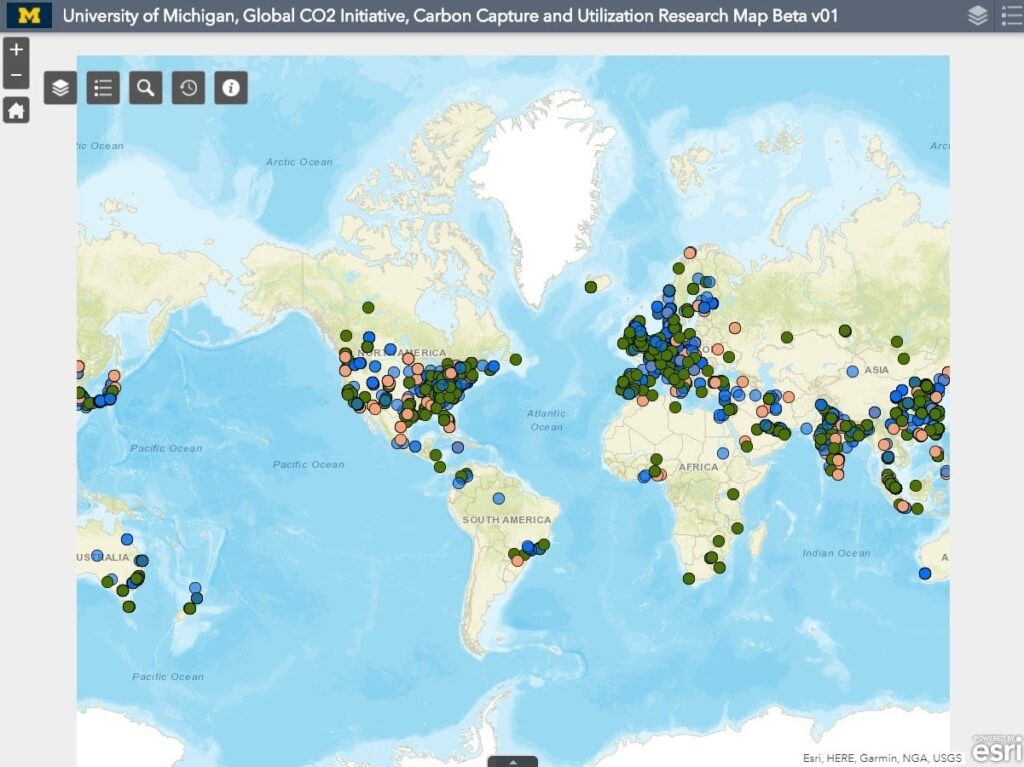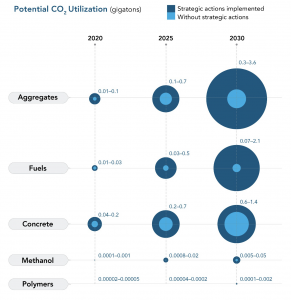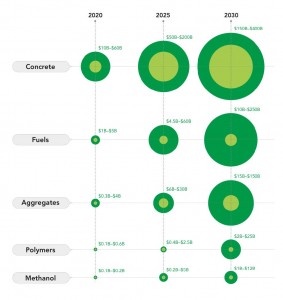
Market potential estimates in our Global Roadmap to CO2 Utilization show the opportunity to create a trillion-dollar market by 2030 while using 4 Gigatons of CO2 annually.
Geographic Information System analysis in our global tracker of research, policy, and startup locations provides deep insights into the confluence of research, commercialization, and policy drivers.
- Environmental and Economic Feasibility of CO2 Utilization
- Market Potential
- CCU Activity Hub
1. Environmental and Economic Feasibility of CO2 Utilization
Which CO2 utilization technologies bring the most environmental and economic benefits? How can two technologies be compared to each other in a consistent manner? It is vital to thoroughly quantify and assess while still in laboratories—such that the transition to mass production is as green as possible.
Those using this information to make decisions on technology development, deployment, investments, and policies have articulated strongly that harmonized guidance is needed to allow transparent and comparable information for objective decision making.
The Global CO2 Initiative took on that challenge and developed Techno-Economic Assessment & Life Cycle Assessment Guidelines for CO2 Utilization in collaboration with EIT Climate-KIC partnered with a team of European researchers at:
University of Sheffield (P. Styring)
IASS Potsdam (B. Olfe-Kräutlein)
TU Berlin (R. Schomäcker)
RWTH Aachen (A. Bardow)
Download the Techno-Economic Assessment & Life Cycle Assessment Guidelines for CO2 Utilization (V 1.1) and worked examples of how to apply the TEA and LCA guidelines.
- A Guide to Goal Setting in TEA: A Worked Example Considering CO2 Use in the Domestic Heating Sector (DOI 10.3998/2027.42/154988)
- Building an LCA Inventory: A Worked Example on a CO2 to Fertilizer Process (DOI 10.3998/2027.42/154989)
- Interpretation of LCA results: A Worked Example on a CO2 to Fertilizer Process (DOI 10.3998/2027.42/154990)
- Methanol Worked Examples for the TEA and LCA Guidelines for CO2 Utilization (DOI 10.3998/2027.42/145723)
- Global CO2 Initiative Complete Mineralization Study 2018 (DOI 10.3998/2027.42/147467)
- Global CO2 Initiative Complete Oxymethylene Ethers Study 2018 (DOI 10.3998/2027.42/147468)
With broad international interest in these Guidelines and related Case Studies, work now continues with the CO2NSISTENT project to further advance the guidelines and to coordinate and harmonize with related work in the US and Europe.
Making Sense of Techno-Economic Assessment & Life Cycle Assessment Studies for CO2 Utilization: A guide on how to commission, understand, and derive decisions from TEA and LCA studies. The CO2NSISTENT project developed this report that provides user-centered guidance on how to commission and understand TEA and LCA studies for CCU, and how to determine whether existing studies are eligible to be used in a decision making process. In addition, this report is meant to ensure that disciplinary expertise is effectively taken up by decision makers and all potential audiences.
A series of workshops to work with and inform researchers, practitioners, decision makers, and students was launched in 2018 in Brussels, Belgium, and continues in collaboration with additional partners:
National Energy Technology Laboratory (NETL)
National Renewable Energy Laboratory (NREL)
Argonne National Laboratory (ANL)
Carbon 180
Volans
National Research Council (NRC)
2. Market Potential
Our global roadmap shows the commercialization potential of carbon dioxide utilization technologies (CO2U) through 2030. A significant reduction of carbon emissions is crucial to avoiding enormous economic and environmental damages.
Renewable power generation and other low- and zero-carbon technologies are an important part of the solution.
Carbon negative technologies (those that reduce atmospheric CO2 concentrations) are also needed to achieve the agreed global goal of keeping temperature increases well below a 2°C increase over pre-industrial levels.
CO2U technologies can play an important role but had not yet received enough attention nor had their potential been comprehensively explored in a comprehensive fashion until a detailed market assessment study that was completed earlier in 2016 by the Global CO2 Initiative.
The study projects that CO2U has the potential to utilize billions of tons of CO2 and generate trillion-dollar markets by 2030. One goal of that study is to create greater awareness concerning the potential for developing and deploying profitable, emissions-negative CO2U technologies on a mass scale.
Read the roadmap document and a detailed report that informed the writing of the roadmap.
3. CCU Activity Hub
Carbon capture and utilization technologies (CCU) are expected to fuel a trillion dollar market that is increasingly attractive to investors, policy makers, and environmentalists.
Accordingly, activity and research in the CCU space has exploded in the past decade. Policy, start-ups and areas of research are constantly evolving.
To help organize and promote the further development of CCU technologies, we offer this ecosystem map, which allows users to view research articles, centers, start-ups, policy, and more, on a worldwide scale through an interactive, searchable map, which includes over 3,000 research articles, 50 research centers, and more.
Select the image to be directed to the interactive version of the map.
Source
Global CO2 Initiative, evaluation, press release, 2020-08-31.
Supplier
Share
Renewable Carbon News – Daily Newsletter
Subscribe to our daily email newsletter – the world's leading newsletter on renewable materials and chemicals











